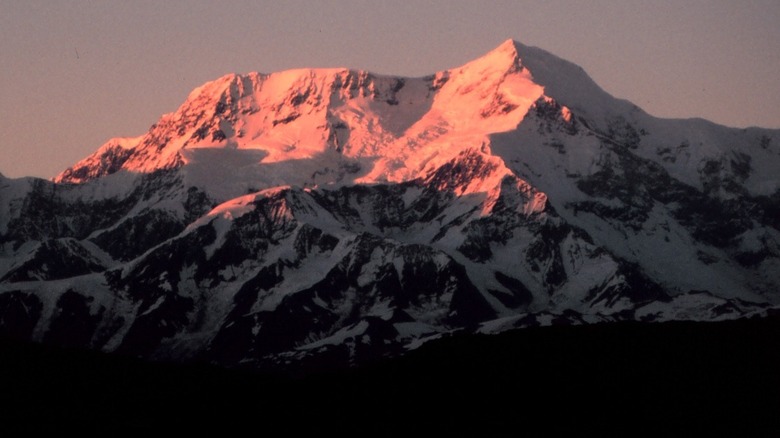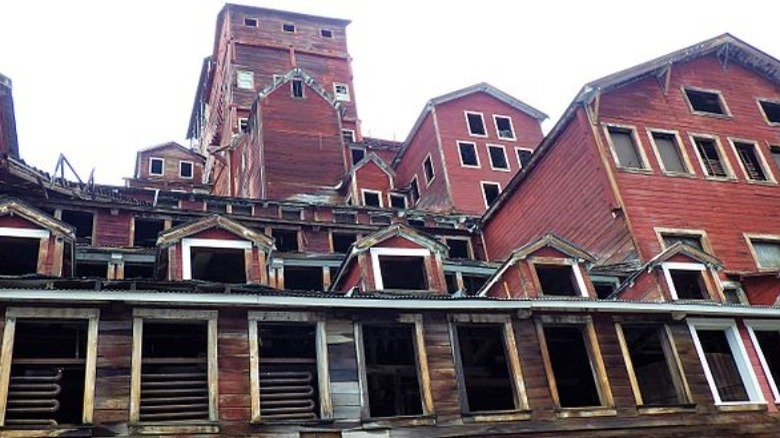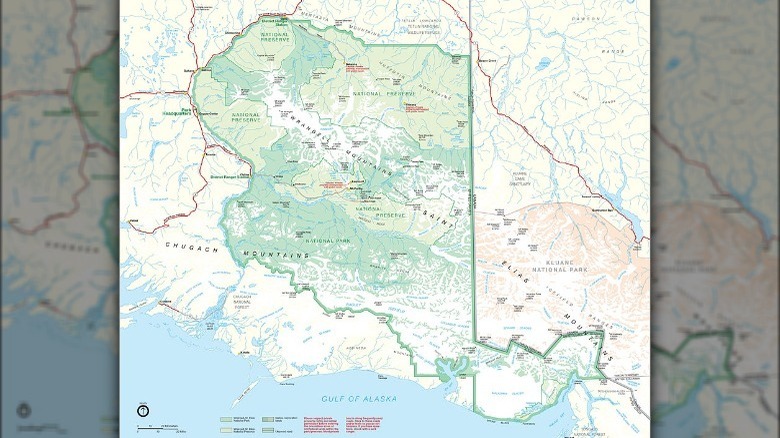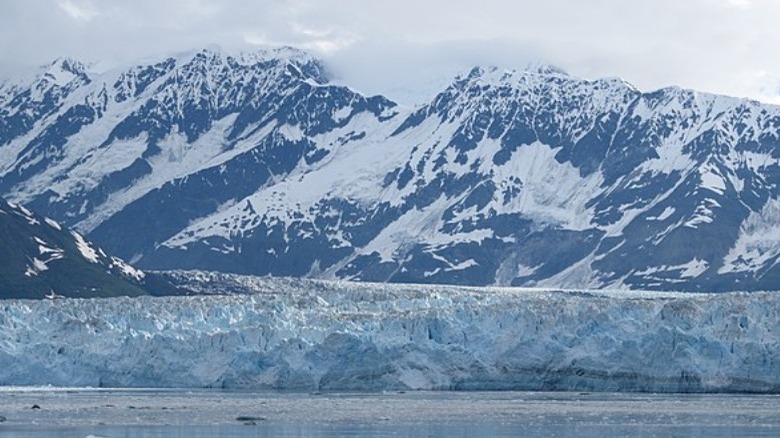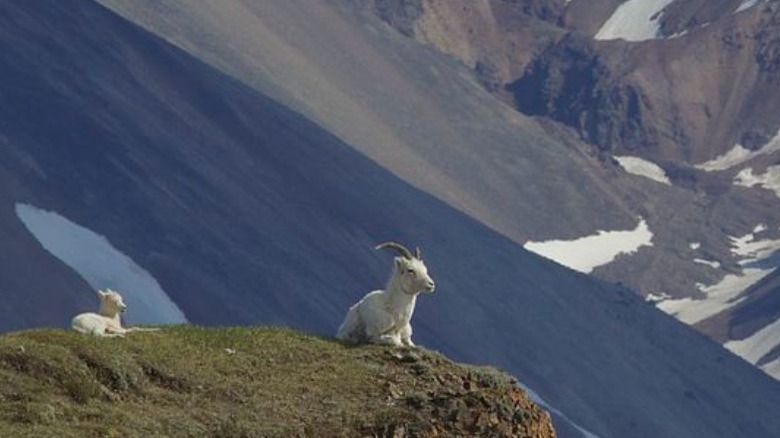America's Largest National Park Has Millions Of Acres
What is the largest national park in the United States? You might suspect the three-state spanning Yellowstone, or the giant-sequoia-hosting Yosemite. But it turns out there's another park that's as large as both of those put together, with the country of Switzerland thrown in, according to its website. That's the park of Wrangell-St. Elias in Alaska, which covers a full 13.2 million acres. That's actually six Yellowstones' worth of protected land, the National Park Service said further.
Wrangell-St. Elias National Park and Preserve is located in southern Alaska, along the border with Canada's Yukon Territory and about 250 miles east of Anchorage. Three mountain ranges come together inside its boundaries: the Chugach, Wrangell, and St. Elias mountain ranges, according to National Park Foundation. It also includes the eastern stretch of the Alaska Range, according to the park website. The mountains mean the park covers a lot of vertical ground too, stretching from sea level to 18,008 feet. That high point is Mount St. Elias (above), which is the second-highest peak in the U.S.
But that's not all. The park also includes nine of the U.S.'s 16 highest mountain peaks. Its glaciers are not slouches either. The Nabesna Glacier is the longest valley glacier on the North American continent, and the Malaspina Glacier is larger than the entire state of Rhode Island. In addition to being the largest U.S. national park, it is also the largest wilderness area in the National Wilderness Preservation System.
History
The area that became Wrangell-St. Elias National Park was originally home to the Ahtna, Upper Tanana Athabascans, Eyak, and Tlingit indigenous peoples. They still live near or within the park and practice their traditions there, according to the National Park Service. The first Europeans to reach the area were Russians in search of fur in the late 18th century. However, the area didn't really draw attention until copper and gold were discovered there in 1899, according to Hiking Alaska's Wrangell-St. Elias National Park and Preserve. This led to a classic boom-and-bust story. A copper mine went live near the Kennecott glacial moraine with the arrival of a railway in 1911. A mining town at Kennecott soon developed, as well as a second town five miles away called McCarthy where miners could actually drink. But, less than 30 years later, the copper was all dug up.
That same year, 1938, offered a hint of the area's second act. That was the year that future Alaska governor Ernest Gruening flew over the area as Director of U.S. Territories, according to the National Park Service. He was so struck by what he saw that he wrote a letter to then-Secretary of the Interior Harold Ickes recommending it for a national monument and eventually a national park. "It is my unqualified view that this is the finest scenery that I have ever been privileged to see," he gushed.
A park is born
Wrangell-St. Elias wouldn't actually become a park for more than 40 years. Interior Secretary Harold Ickes did take Ernest Gruening's suggestion seriously and pitched the idea of making the area a national monument to President Franklin D. Roosevelt in 1940, according to the National Park Service. However, Roosevelt was too busy with the outbreak of World War II to follow up on the suggestion. President Jimmy Carter was the one to finally make 10,950,000 acres of Wrangell-St. Elias a national monument in 1978. That same year, the United Nations Educational, Scientific and Cultural Organization (UNESCO) designated it and the bordering Kluane National Park in Canada as the first ever World Heritage Site to cover two different countries, the National Park Service said further.
Wrangell-St. Elias was granted full national park status after the Alaska National Interests Lands Conservation Act was passed in 1980. This act ensured federal protections for 104.5 million acres of Alaska. In November of that year, President Carter preserved the full 13.2 million acres of Wrangell-St. Elias National Park. That wasn't the end of the area's conservation history, however. In 1993, UNESCO added Alaska's Glacier Bay National Park and Preserve and the Alsek-Tatshenshini Provincial Park in British Columbia to the World Heritage Site to create one of the world's largest international protected areas, at 24.3 million acres. The four parks contain the largest ice field that isn't located at the North or South Poles, according to UNESCO.
Fire and ice
Wrangell-St. Elias National Park is home to fascinating examples of both geology and hydrology. The Wrangell Mountains were once volcanic, although only Mount Wrangell is still active, according to the National Park Service. However, it's no slouch, being one of the largest active volcanoes by volume anywhere in the world. It last erupted in 1930, but it's possible to see it steaming on cold days.
The park is also famous for its glaciers. UNESCO noted that the entire World Heritage Site it belongs to is one of the best places to watch glaciers actively form a landscape. The U.S. park itself is home to the largest glacial system in the country, according to the National Park Service, and the glaciers cover 35% of the park and feed many of its rivers. At 127 miles by six feet, its Bagley Icefield is the largest non-Arctic icefield in the world, the National Park Service said further. It gives birth to many glaciers including the Hubbard, which is, with a flow of more than 75 miles, the longest tidewater glacier in North America. Unlike many glaciers in the world, the Hubbard Glacier is actually getting bigger because of climate change, according to VOA Learning English. That's because global warming is making it rain and snow more in the park, which adds to the glacier's mass.
Off the beaten track
Despite its size, Wrangell-St. Elias National Park is not popular with travelers. It is, in fact, the eighth-least-visited of the U.S. national parks, according to CNN, drawing only 50,189 recreation visitors in 2021. This is likely because it's not very easy to get to. Only two roads access the park and both are gravel, according to the National Park Service. Most of the park area is backcountry and the coastal section can only be reached by plane or boat, the National Park Service said further. However, those who do make the effort are treated to much less crowded conditions than other parks. Unlike Alaska's Denali National Park, you don't need a permit to roam the backcountry, which means you can plan your itinerary as you like without worrying about other visitors crowding you out, according to Hiking Alaska's Wrangell-St. Elias National Park and Preserve.
There may not be many human visitors to the park, but it has plenty of non-human animal inhabitants. Perhaps the most famous are the Dall sheep (above), according to VOA Learning English. In fact, the park is one of the top North American gathering spots for these mountainous sheep, hosting around 13,000 of them, according to the National Park Service. It's also home to all three species of North American bears: grizzlies, black bears, and polar bears. Caribou, bison, mountain goats, and wolves also live in the park, so, if you make the trip, you'll be in good company.
